General
A JHM Exclusive: A Full Transcript of Pixar’s Quarterly Earnings Conference Call
Finally, here’s your chance to read — in full — the teleconference where Pixar’s CEO Steve Jobs finally spoke his mind about Michael Eisner and the Walt Disney Company … which set all these wheels in motion.

Hey, gang!
Jim Hill here. I hope you all had a safe and restful Presidents Day Weekend.
Me? I didn’t get much of a chance to rest. Why for? My e-mail box kept getting filled with notes from JHM readers who wanted to know more-more-MORE about this whole Roy/Stanley/Michael/Steve/ Brian and the other Steve story. What was going on RIGHT NOW. What I thought might happen next. And — more intriguingly — what I thought had led the Walt Disney Company to this intriguing crossroads in the corporation’s history.
Unfortunately — in order to properly connect the dots, to clearly illustrate all of the little, subtle behind-the-scenes things as well as the huge, momentous decisions that lead us to this exact moment — that would take pages and pages to properly lay out. In other words, a book.
On the upside, I am actually giving some semi-serious thought to putting together such a book. But we’ll talk more about that later …
But — if you were to ask “What moment truly signified to you, Jim, that Michael Eisner was really in trouble, that change was in the wind for the Walt Disney Company?” — I’d have to say that it was Pixar’s quarterly earnings conference call back on February 4th.
That (for me, anyway) was the moment when the gloves came off. Sure, Roy and Stanley’s www.savedisney.com efforts had already gotten the Disneyana faithful and some members of the investment community recruited to their cause. But a lot of Wall Street’s movers and shakers were still sitting on the fence. As was the mainstream media.
But when Steve Jobs got on the phone 13 days ago and started talking about how he was just …
“… sick about (the idea of ) Disney doing sequels (to Pixar’s films) because — if you look at the quality of their sequels like “Lion King 1½” and their “Peter Pan” sequel and stuff — it’s pretty embarrassing.”
… that’s when people in high places finally sat up and took notice. Particularly those folks who have offices high up in the Team Disney Burbank building. As reporters began grabbing the more sensational quotes out of Pixar’s quarterly earnings teleconference and plastering them all over the place, that’s when Eisner and Co. supposedly finally realized that the situation that Disney management finally found themselves in was serious. Which is why they began to circle the wagons.
Now, I know that you’ve already read select excerpts from the Pixar’s quarterly earnings conference call of February 4th. A few stray quotes here and there. But here — finally — is a full transcript of that historic teleconference. (Well, as close to a full transcript as I could get before Pixar finally pulled the thing off the Web …)
Anyway … if you’d like to learn what exactly it was that made Wall Street finally decide that Disney might be in trouble, take a gander at the following transcript:
Your speakers today are Steve Jobs, Chairman and Chief Executive Officer, and Ann Mather, Executive Vice President and Chief Financial Officer. I would now like to turn the conference over to Ann Mather. Please go ahead.
AM: Thank you. Welcome to Pixar’s fourth quarter of fiscal 2003 conference all. I will begin with a discussion of our financial results, followed by our outlook for 2004 and beyond. I will then turn the call over to Steve Jobs, who will provide an update on other developments at Pixar. Who will then open the call to questions.
We are thrilled to report the most profitable quarter and full year in Pixar history. Fourth quarter revenues were $164.8 million, net income was $83.9 million and diluted earning per share were $1.44. These results compared to revenues of $39.4 million, net income of $17 million and diluted earnings per share of $.31 reported in the fourth quarter of 2002. Full year of 2003 revenues were $262.5 million, net income was $128.4 million and diluted earning per share were $2.17. This exceeded previous guidance of $1.76 for the year and compared to full year of 2002 revenues of $211.7 million, net income of $90 million and diluted earnings per share of $1.98.
Film revenues for the fourth quarter were $161.3 million, which include $147.8 million of “Finding Nemo” related revenues, primarily from domestic home video sales and foreign box office revenues. Also included in our revenues were $8.3 million from our library titles, $5.2 million associated with “Monsters, Inc.” and approximately $3.4 million from software licensing.
For the fourth quarter, we generated “Finding Nemo” domestic home video sales of 24.8 million units. Comprised of 5.6 million VHS units and 19.2 million DVDs. International releases of the home video were limited in the fourth quarter with revenues almost entirely offset by upfront marketing and release costs. The majority of “Nemo” ‘s international home video release dates are staggered throughout the first part of 2004. And we will provide further guidance on this subject during the discussion of our outlook for 2004 later in the call.
As of the closing day of our fourth quarter, “Finding Nemo” had generated $792 million of worldwide box office receipts. Compromised of $340 million domestic and $452 million international. Since that time, the film has been released in all of its scheduled international markets and has continued to climb to a worldwide box office of $850 million.
Operating expenses were $6.8 million for the fourth quarter and $30.5 for the full year of 2003. Compared with $5.7 million and $19.5 million respectively for the same period in 2002. The increase in operating expenses over the prior year period was largely attributed to a one time incentive compensation to our employees earlier in the year for their contribution to the extraordinary performance of “Finding Nemo.” Cash, cash equivalents and investments were approximately $521.9 million at the end of the fourth quarter. Having increased $182.8 million since December 28, 2002. This increase was mainly attributable to cash received from Disney for our share of film revenues as well as proceeds from stock options exercises, software revenues and interest income. Offset by film production costs and tax payments.
Capitalized film cost were $107.7 million versus $92.1 million at the end of 2002, reflecting production spending on our current film projects offset by film amortization of $37.6 million. Our balance sheet remains debt free and our retained earnings at the end of the fourth quarter were $393.3 million. Our fiscal year 2003 diluted earnings per share of $2.17 exceeded our previous guidance of $1.76 with the exception of two cents of our fourth GPS upside which was due to unanticipated software sales. The majority of our out-performance this quarter was attributable to “Nemo” ‘s greater-than-expected worldwide box office and domestic home video revenues. At the international box office, “Nemo” generated $452 million of foreign box office receipts by the end of the fourth quarter versus our previous estimate of $300 million. On home video, we recognized 24.8 million video units domestically versus our previous expectations of between 22 and 24 million units. Please note that we maintain certain return reserves of “Finding Nemo” home video as we have for all of our previous titles and that these reserves may differ from the reserves estimated by Disney. In addition, our reserve estimates may be adjusted periodically based on actual rates of return, inventory levels in the distribution channel as well as other business and industry information.
I would now like to address upcoming events that may effect results for the first quarter as well as introduce our initial thoughts on fiscal year 2004. Please note that these statements as well as others that may be made in the course of this presentation are forward looking and are just possible that actual results may differ materially. We refer to our 2002 Form 10K and third quarter 2003 Form 10Q, particularly the sections and regs containing important factors that may cause actual results to differ. These forward looking statements should not be relied upon as representing our views as of any subsequent date and we undertake no obligation to update these forward looking statements to reflect events or circumstances after the date they were made.
We anticipate that our earnings for the first quarter of 2004 to be driven by the continuing success of “Finding Nemo.” Our projections assume that “Nemo” could eventually achieve a worldwide box office of roughly $855 million with the remaining foreign box office receipts being recognized in the first quarter. We also expect international home video revenues — most notably from Australia and the United Kingdom, where the home video releases are schedule for January and February respectively. In addition, we expect to recognize some domestic television revenues from pay-per-view, continuing worldwide merchandise revenues and ancillary royalties. As a result, we expect to report diluted earnings per share for the first quarter of 2004 of roughly $.30. Beyond the first quarter, we expect continuing home video revenues of “Finding Nemo” to continue to drive the second quarter particularly from its release in major European territories such as France, Germany, Italy and Spain in April, and in Japan in May. Revenues for the domestic pay TV licensing of “Nemo” are expected for the second quarter while worldwide merchandise revenues and ancillary royalties from all of our films are anticipated throughout 2004.
Our financial results for the fourth quarter of 2004 will depend primarily on the success of our studio’s sixth feature film, “The Incredibles.” And though very difficult to estimate before its domestic theatrical release on November 5th. As a result, we are not providing EPS guidance for the full year. We expect that “The Incredibles” will be released in a majority of international territories throughout the fourth quarter. This will give 2004 three major revenue drivers: Domestic and international theatrical for “The Incredibles” and international home video for “Finding Nemo.”
Looking forward to 2005, this will be the first year that Pixar experiences four major revenue drivers: With domestic and International home video of “The Incredibles” in the first half of the year, and domestic and international theatrical for “Cars” in the second half. 2006 will also have four major revenue drivers. But — for the first time — Pixar will be keeping 100% of the profits after distribution fees from two of those revenue streams: Domestic and international theatrical for Film 8, our first film outside of our co-production agreement.
Throughout 2004, 2005 and 2006, we expect continued worldwide home video, television licensing, merchandise sales and ancillary royalties from all of our films released to date as well as continued software sales and interest payments. These statements are forward looking and actual results may differ materially. Among the factors that could effect projected 2004, 2005 and 2006 results to differ are the following: The timing and worldwide distribution costs of Film 8, “Cars,” “The Incredibles,” “Finding Nemo” and other titles in our film library; the timing, accuracy and efficiency of the information that we receive from Disney to determine revenues and associated gross profits; the timing and amounts of non-film related revenue and expenses; the accuracy of assumptions and judgments used to estimate certain revenues associated with gross profits; the market price of our common stock and related volatility; potential delays in the release dates of our films; final terms of our future distribution deal and external socio-economic and political events that are beyond our control.
“Finding Nemo” ‘s unprecedented performance in both the international box office and on home video are landmark achievements in Pixar’s history. 2003 stands out as our most successful year to date and we expect this momentum to carry us into 2004, with “Finding Nemo” ‘s foreign home video release and — later — with the release of Pixar’s next film, “The Incredibles” on November 5, 2004. For more on “Finding Nemo,” “The Incredibles” and beyond, I would now like to turn this discussion over to Steve Jobs.
SJ: Thanks, Anne. As Anne said, we are thrilled to report the most profitable quarter and full year in Pixar’s history. Our 2003 revenues of $262 million, net income of $123.7 million and diluted earnings per share of $2.15 show that the business models that we put in place many years ago is working quite well. We are very proud of these numbers. But we are even prouder of what generated them: The phenomenal success of “Finding Nemo” which became the highest grossing animated film of all time.
“Finding Nemo” ‘s worldwide box office currently stands at $850 million, comprised of $340 domestic and $510 international. It is the highest grossing film of 2003 and the ninth highest grossing film worldwide of all time. With “Finding Nemo,” the total worldwide box office for Pixar’s five films has surpassed $2.58 billion.
Let me take a moment to highlight the outstanding international performance of “Finding Nemo.” It is the first animated film to surpass $500 million international markets, the most significant territory released since the last time call Japan set a new opening weekend record and achieved $96 million of box office during its nine weeks in release. “Finding Nemo” was also the highest grossing film during calendar 2003 in Argentina, Australia, Austria, Belgium, China, France, Germany, Hong Kong, Mexico, the Netherlands, Poland, Switzerland, the United Kingdom and Ireland.
“Finding Nemo” also sold 24.8 video units in North America in 2003. Selling 8 million units the first day, to become the fastest selling video ever, beating previous record holder “Monsters, Inc.” which sold 5 million units the first day. In addition, the “Finding Nemo” DVD became the Number 1 selling DVD of all time with 19.2 DVDs being sold in North America in 2003. We’ve won lots of awards for this great DVD.
And — speaking of awards — “Finding Nemo” has been nominated for 4 Academy Awards: Best Animated Feature Film, Best Original Screenplay, Best Musical Score and Best Sound Editing. Plus our new short film, “Boundin’ ” was also nominated for Best Animated Short Film.
It is incredibly important for everyone at Pixar to produce the highest quality products we can. And these nominations and the success of our films means a lot to us. We couldn’t be happier.
Now I’d like to talk about Disney. As most of you know, last week we ended our talks with Disney to extend our relationship after negotiating with them for over 10 months. Let me explain why.
As you may recall, our first deal with Disney was a three picture deal with “Toy Story” being the first picture. After the phenomenal success of “Toy Story,” we were able to negotiate our present deal in terms substantially more favorable for Pixar. As part of this new second deal, the last two pictures of the first deal became the first two pictures of the second deal under its more favorable terms. This is a common practice in Hollywood when a studio seeks to secure a new, longer term deal with a valued partner.
Jumping ahead to 2003, let me quote an LA Times article from earlier this week:
QUOTE: “Several weeks before last year’s release of ‘Finding Nemo,’ Walt Disney Company Chairman Michael Eisner told his board not to expect a blockbuster and suggested that such a fate might not be all that bad. Although Pixar Animation Studio was high on its film, Eisner said that he was not impressed by early cuts he had seen, according to people who were familiar with the matter. ‘Should the movie falter,’ Eisner said, ‘Disney could gain negotiating leverage to expand its partnership with the high flying animation company. Pixar, Eisner concluded, may be headed for a reality check. ” UNQUOTE
We’ve been told the same story by several folks at Disney. As you know, things turned out a little different and “Finding Nemo” would soon make more at the box office than any animated film in history. We finally began negotiates with Disney on a third deal almost a year ago. We had done our homework. We had talked with several other major studios and we had a pretty clear idea the deal we could get from them.
We offered a deal to Disney that was less favorable to us than we could get from several other studios. For example, with much higher distribution fees, a much longer term commitment and free use of our characters in their theme parks. But we held firm that the last two pictures of our current deal — “The Incredibles” and “Cars” — be folded into the new deal with its more favorable terms. Just as we had done before and just as any other studio in town would agree to if they were in Disney’s shoes. In the end, Disney chose not to agree to this.
So — after 10 frustrating months — we ended our talks with Disney. It is not without some regret. We will truly miss working with *** Cook and his terrific marketing and distribution teams. And you would be hard pressed to find someone who loves the original spirit of Disney more than John Lasseter, Ed Catmull or myself. But after almost a year, it’s time to move on.
Since announcing this, we have been fortunate to receive calls from the heads of every major studio in Hollywood. It is clear that we are wanted by others and we will begin discussions with these studios in March. With the goal of striking a new deal with them by this fall.
[MISSED TRANSCRIBING THIS SECTION. SET UP WAS THAT JOBS WOULD NOW ANSWER SOME QUESTIONS THAT INVESTMENT ANALYSTS AND THE PRESS MIGHT HAVE ABOUT THE WHOLE DISNEY/PIXAR SITUATION.]
AM: Can anyone else distribute and market Pixar’s pictures as well as Disney?
SJ: Yes, we think so. One needs to look no further than “Harry Potter,” “Lord of the Rings,” “Spiderman” or “Ice Age” to see examples of excellent marketing and distribution. We think that there are at least four other major studios that will do a great job marketing and distributing our films.
AM: Are other studios interested in working with Pixar?
SJ: I’ve personally received calls from the heads of these companies over the past 5 days. All expressing a very, very strong interest in working with Pixar.
AM: Is Disney planning to make sequels to all the Pixar films we released through them?
SJ: Well, Disney is making noise that they will, but we really don’t know. Disney has the rights to make sequels to our first seven films if we decide that we don’t want to make them ourselves. We have already decided that for “Toy Story.” It is likely that we won’t want to make sequels to any of them ourselves. But we haven’t decided that yet. Our filmmakers are more interested in telling new original stories. And we have demonstrated that our original films like “Monsters, Inc.” and “Finding Nemo” can be even more successful than our sequels like “Toy Story II.”
AM: How does Pixar financially participate in our first seven films and their sequels?
SJ: Though Disney has publicly said that they own our films, this is not true. Although Disney does own the original “Toy Story” because it is covered under our first deal with them, Pixar will continue to own 50% of “A Bug’s Life,” “Toy Story II,” “Monsters, Inc.,” “Finding Nemo,” “The Incredibles” and “Cars.” And will continue to earn its share of the profits from these films, their videos, merchandise, etc. into perpetuity. For example, when Pixar’s films are released on high definition DVDs later this decade, Pixar will continue to earn its current profit split from these DVDs. If Pixar decides not to do sequels and Disney solely finances and creates sequels to Pixar’s films, Pixar will earn a lower cass of royalties on those sequels.
AM: Will Pixar’s future films suffer without Disney’s creative collaboration?
SJ: The truth is there has been little creative collaboration with Disney for years. Pixar creates the original stories then creates and produces the films with very little creative input from Disney. You can compare the creative quality of Pixar’s last three films — for example — with the creative quality of Disney’s last three films. And gauge each company’s creative abilities for yourself. The collaboration that we do have with Disney is centered around the marketing of the films, not the making of them.
AM: Will Pixar’s future films suffer without Disney’s legendary marketing?
SJ: Marketing is important and we have enjoyed working with *** Cook and his talented marketing team at Disney. But no amount of marketing will turn a dud into a hit. Not even Disney’s marketing and brand could turn Disney’s last two films — “Treasure Planet” and “Brother Bear” — into successes. Both bombed at the box office. The “Thumbs Up” and “Thumbs Down” you hear from colleagues at the water cooler overshadows the most skillfull marketing in the world. The quality of the movie is far more important than the marketing of the movie. And — as I said — there are at least four other studios with strong marketing organizations that are very interested in working with us.
AM: Will Pixar’s future pictures suffer without the Disney brand?
SJ: Beginning with “Monsters, Inc.,” the results of Disney’s own market survey research showed that the Pixar brand had become more important than the Disney brand to draw moviegoers to see our films. Both for parents with children and adults without children. We think that the Pixar brand is the most powerful and trusted brand in animation. And it gets even stronger with every successful film that we release.
AM: Is there still a chance that Pixar and Disney will get back to the bargaining table?
SJ: It’s not very likely. It’s very unlikely. After more than 10 frustrating months of negotiations, we were unable to strike a deal with Disney. And now it’s time to move on.
AM: Is Disney going to be less motivated to make “The Incredibles” and “Cars” as successful as prior Pixar films now that the marriage is coming to an end?
SJ: Disney needs these films to be successful as much as Pixar does. Remember, a very significant percentage of Disney studio’s profits over the few years have come from Pixar films.
AM: How good are “The Incredibles” and “Cars” going to be?
SJ: We think they’re going to be outstanding. The preview screenings for “The Incredibles” have been outstanding, even more positive with teens than any previous Pixar film at this stage. But you never really know ’til the movie is released. Which — for “The Incredibles” — is this November 5th. And we couldn’t be more excited about it.
“Cars” — John Lasseter’s next movie and Pixar’s seventh movie — is coming along quite nicely and it’s on track for a holiday 2005 release. We recently announced the voice cast of “Cars” which includes Paul Newman, Owen Wilson, Bonnie Hunt and NASCAR Legend Richard Petty. We think it’s going to be great.
AM: What about 2006 and beyond?
SJ: We already have our 2006 picture in production and hope to greenlight our 2007 picture by the end of this year. Lost of excietemnt here but we’re going to save any announcements for another day.
AM: Is it Pixar’s plan to finance 100% of its new films after “Cars” and can Pixar afford to do this?
SJ: Yes. It is Pixar’s plans to finance 100% of our new films beyond “Cars.” So we can keep the largest possible share of the profits we are creating. Unfortunately, we can easily do this. Pixar has over $520 million in cash in the bank at the end of 2003, and we expect to have over $650 million of cash in the bank by this summer. If our next two films do as well at the box office as we hope, we project that Pixar will have $800 million to a billion dollars of cash in 2006. And that’s net of funding 100% of our next pictures.
AM: How will a new deal effect Pixar’s financial results in 2006 and beyond?
SJ: While we can not predict the success of our future films, we can say that — had “Finding Nemo” been a film under the terms of the new deal we hope to make, our 2003 revenues of $262 million and net revenues of $123.3 million would have more than doubled. I’ll leave it to you to calculate what our stock price might be with $250 million in earnings using Disney’s PDE ratio of 35.
AM: How does the senior management team at Pixar feel about splitting with Disney?
SJ: Honestly, we’re sad about it. You can not find anyone who loves the original spirit of Disney more than John, Ed and myself as I said. But after 10 months of trying to strike a deal with Disney, we felt it was time to move on. So we’re focused entirely on three things now. 1) Making sure our movies are the best we can make them. 2) Insuring that we get to one picture a year without sacrificing our quality and 3) Finding a new studio partner to distribute our pictures beginning in 2006. Just two years away. I’m confident that we will succeed at all three of these and that Pixar’s Golden Age will continue to evolve without missing a beat.
And now Ann and I would like to open it up for any remaining questions that we haven’t answered.
Q: A little more insight in the process with Disney that ultimately lead you to walk away. I know that you said that you feel that there are stronger or just as strong distribution partners. But it seems to me that Disney has the platforms that appeal the most to your core demographic and that’s been the families . And given the deal terms that Disney suggested that you were offering, what was out there being suggested that you offered to Disney, what is from your commentary that you were suggesting that the last two movies become a part of a straight distribution deal, it would seem to me that Disney was in a position that the almost had to say “No”. Given how lucrative the deal with Pixar has been thus far. So I guess my question is — was — is — you know — was it a straight distribution with nothing else as far as your discussions with Disney? Would you have not been happier or would you have been willing to take the higher amount on the split going 50/50 say, going 80/20 or even 90/10 as opposed to just a straight distribution deal. Because I’m having a hard time figuring out how the numbers, you know the numbers you’re going to be able to get a distribution deal that’s more favorable. By the way, we had heard that the offer to Disney was 10% distribution on the next two movies, relinquishing all the rights they have thus far on the existing library and then after the current deal is done, you’d pay them a 7% distribution fee. And — unless you’re assuming that you’re getting much, much better than a 7% distribution fee that your future films are going to “Nemo” -like number and that Disney will do a halfway decent job on the sequels and do many of them. You know it’s hard for me to see how the numbers balance out. So that’s the first question.
SJ: I think your data’s just wrong. And I’m not going to specifically go into what the negotiations were. But we were offering Disney much higher distribution fees than you said. Both for the next two films and the films beyond that. But the line in the sand that we drew was that we want to own our films going forward. And we wanted to own “The Incredibles” and “Cars.” And — in the end — Disney wasn’t willing to agree to that. So we thought we were willing to accept a quite reasonable deal, but Disney felt differently and that’s their right and privilege.
Q: Okay. Just two quick follow-up questions then. Would the sequels … How does John Lasetter feel about Disney doing the sequels is Question No. 2. And Question No. 3 is if you do invoke your right of first — if Disney comes to you and and can you confirm that you basically said that officially said no to doing a “Toy Story” sequel?
SJ: Um … We have said “No” to doing “Toy Story III.” We have not said “No” to anything else yet. We will be discussing that amongst ourselves and with Disney over the next several months. And we feel — ah — sick about Disney doing sequels because if you look at the quality of their sequels like “Lion King 1 ½” and their “Peter Pan” sequel and stuff, it’s pretty embarrassing.
Q: Okay. Just a quick follow-up on your refusal, like if you if Disney comes to you and says “we want Let’s say that you had said “No” to “Toy Story III” and you had said “Yes” is there a limited amount of time in which you have to make those movies? Could you have said “Yes” and made the movies four years from now?
AM: You know, Kathy, I think we need to move on. We’ve said as much as we think is appropriate about sequels.
Q: With the amount of cash you on the balance sheet, whether you choose to make sequels or you choose to make all new films, what’s the constraint from you make multiple pictures a year? There’s certainly consumer demand and you’ve got the capital.
SJ: Rich, if it were only financial capital that was required to make successful animation features, we’d be seeing a lot more successful animated features. It is the talent that is the limiting factor. We have spent the 10 years at Pixar growing our creative talent base and our technical talent base. These are skills that you can go and acquire on the outside. There are not people out there that know how to do these things that you can go hire. So you have to grow them. And that is what Disney did in its Golden Age of Animation a decade ago. That’s what Pixar has done. And that’s what we think anyone has to do. Talent is the limiting factor. And I think Disney tried to ramp up from a picture a year to two pictures a year and that may have been one of the contributing factors that got them to where they are today in animation.
Q: Just out of curiousity, do any of the joint venture partners bring development prospects that could help ease that constraint?
SJ: There’s nothing on the radar screen to that effect, No.
Q: With respect to library, can Disney go out and development deals by themselves or does Pixar need to sign off on that? Secondly, Pixar has the right to co-produce sequels under existing terms for perpetuity or or — and this is a hypothetical — but is there any sort of timeline that if Disney does not produce a sequel or sequels can Pixar greenlight a sequel with only Disney the royalties fee should they not decide to participate.
AM: The library output deal in respect to television, right?
Q: Yeah.
AM: We are consulted on all TV deals negotiation to make that they’re good — um — because Disney owns so many television assets. And there’s an obligation under the contract that there’s a fair, fairly set price and Disney ahs been very good about consulting us in those discussions.
SJ: As far as sequels go, we have the right to elect and co-produce sequels. If we decide not to do that for a film, we lose that right for future films. The way to understand our thinking on this is that if we have the talent to produce one animated film per year and our creative talent has demonstrated that it can produce original films that actually do better at the box office than our sequels. As “Monsters, Inc.” and “Finding Nemo” have done compared to “Toy Story II.” Then those slots might get filled up with original films and not leave any remaining room for sequels. So — if you care about quality (Which we do) — You know, it’s hard to see how we could turn out high quality sequels if we don’t have any slots left.
Q: As you guys look at potential future deals with other partners, other studios do you just discuss your interests in retaining full distribution rights in certain windows, be it video, merchandise or video games. Taking full control of that stuff. And — if so — what sort of staffing requirements would you need and what sort of lead time would you need to build up a prescence or the infrastructure to do that sort of stuff?
SJ: Yes, we have thought about that and I think that there will be areas of merchandising and things like video games where Pixar will play a much more active role than we have in the past. Our first film under such a deal will be in 2006. We think that we have adequate time to staff up for that. The staffing requirements for that I don’t think will be terribly large.
Q: Steve, as you look toward the future in terms of deciding a new distribution partner beyond “Cars,” I’m going to go ahead and assume that you are thinking that distribution domestically is largely a commodity there’s really no one here in town that does it better than anyone else. But internationally clearly there are those studios that distribute more effectively than others studios and there are actually other studios that don’t distribute internationally at all. MGM comes to mind, of course. Given that, is MGM out of the running and do you think that there are other studios here in town that distribute internationally better than others and what do you look for in making that decision?
SJ: Well, we have absolutely already looked at that question very intimately, examined cases of films that have been distributed domestically and internationally and look at them in great detail. We’re very on top of that. And I’m not going to go into any of our thoughts about that right now except to say that we’re very on top of that issue. And international distribution is very important to us.
Q: If you could comment on future deal that you sign. Obviously, Disney picks up 100% of the P and A and then they recoup it so none of it flows through your P and L which definitely helps your earnings. Going forward with any deal that you would sign with another partner, would you look to sign a similar kind of deal or would Pixar look to pick up some of that P and A spending and have that float through your P and L. Second, I’m wondering out of the four studio heads that you’ve talked to or you considered to be quality studio heads that distribute your productions in the same manner of Disney, I’m wondering whether or not any of them have made what you have to consider to be overtures something a little bit deeper than just a distribution agreement along the lines of has the topic of acquisition or merger even come up or has that offer not even been addressed. And — finally — I’m curious if you think that Michael Eisner still likes his iPod?
SJ: We’ve talked to more than four studio heads. I’m not going to get into those discussions at this point in time. In terms of running the P and A through Pixar or through a partner, that actually wouldn’t effect the earnings. It would effect the cash flow requirement.
AM: Steve’s right. We’re looking at the timing. Obviously, the recognition of the expenses. But we’re looking at ways to structure a deal so that there would be no impact on Pixar’s financial results. Depends on the structure of the deal.
We would look for a deal that would be consistent from the existing deal to look at.
I’ve said as much as I can.
Q: Is there any scenario where you can see yourself working with Disney on the production of a sequel under the current terms (which I think is unlikely) or could you possibly negotiate a specific deal that would address only sequels?
SJ: You know, as I mentioned, our limiting factor is producing a film a year. Which we will get to shortly. And of it as we have a slot a year to fill. And if our incredibly talented creative team can fill each of those slots with original pictures which we’ve already demonstrated can be quite successful even relative to successful sequels then we don’t have any slots left to do sequels. So that’s the sort of decision making process that we’ll be going through the next several months.
Q: It would seem that you could get a better return on that money if you did do a sequel and had some overview of what Disney was doing. Why wouldn’t that work out? And could you address the question that John Lasseter has a “Toy Story III” script that he thought was better than anything that they had. Why couldn’t you work out a deal to give them that so or something or other. Whatever that might be.
AM: I think we’ve said as much as we’re going to say about the sequel matter today.
Q: Just curious if we should expect any TV related revenues from “Monsters, Inc.” in 2004?
If we could take a step back. Post “Lion King,” Hollywood took a step in animation lost money while driving up animators salaries. Are we at risk with the same gold rush mentality in the next few years. Could we see your costs rise as others try to access your talent? Following up on that, what sort of protections do you have on Disney in a non-compete basis?
SJ: Well, I think we are seeing everyone try to get into 3D computer animation thinking that the medium is the most important thing. An opinion that we don’t share. But we have not seen the industry go through the cost escalation we went through the last time that this happened with 2D animation, as you pointed out. As far as Disney, we have an agreement in place that neither company hires people who have worked at the other company during the prior six months.
AM: And I believe when the deal ends, that expands to two years.
SJ: Yeah, we need to check that.
AM: But — at the end of the deal — it becomes ever more significant.
SJ: Or it may survive the deal for two years. Yeah. That may be it.
Q: Disney and Pixar have had a very mature relationship in terms of not hiring people from the other company and we have that in the agreement. I don’t think that there will be any problems there.
So — as we’re modeling out what it costs to produce these films, we should keep the same figures in place.
SJ: Well, our employees do appreciate raises now and then.
AM: And there is a rate of inflation.
SJ: Thank you for joining this call. We know that there is clearly change in the air and some people are disquieted by change but we feel very, very strongly that Pixar is on the right track and the best days are yet to come.
Pretty interesting reading, don’t you think?
General
Seward Johnson bronzes add a surreal, artistic touch to NYC’s Garment District

Greetings from NYC. Nancy and I drove down from New
Hampshire yesterday because we'll be checking out
Disney Consumer Products' annual Holiday Showcase later today.
Anyway … After checking into our hotel (i.e., The Paul.
Which is located down in NYC's NoMad district), we decided to grab some dinner.
Which is how we wound up at the Melt Shop.

Photo by Jim Hill
Which is this restaurant that only sells grilled cheese sandwiches.
This comfort food was delicious, but kind of on the heavy side.

Photo by Jim Hill
Which is why — given that it was a beautiful summer night
— we'd then try and walk off our meals. We started our stroll down by the Empire
State Building
…
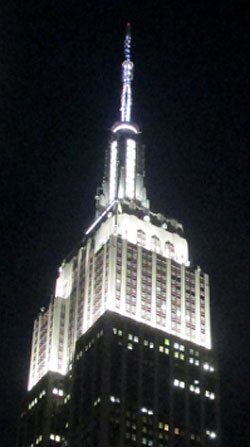
Photo by Jim Hill
… and eventually wound up just below Times
Square (right behind where the Waterford Crystal Times Square New
Year's Eve Ball is kept).

Photo by Jim Hill
But you know what we discovered en route? Right in the heart
of Manhattan's Garment District
along Broadway between 36th and 41st? This incredibly cool series of life-like
and life-sized sculptures that Seward
Johnson has created.

Photo by Jim Hill
And — yes — that is Abraham Lincoln (who seems to have
slipped out of WDW's Hall of Presidents when no one was looking and is now
leading tourists around Times Square). These 18 painted
bronze pieces (which were just installed late this past Sunday night / early
Monday morning) range from the surreal to the all-too-real.

Photo by Jim Hill
Some of these pieces look like typical New Yorkers. Like the
business woman planning out her day …

Photo by Jim Hill
… the postman delivering the mail …

Photo by Jim Hill
… the hot dog vendor working at his cart …

Photo by Jim Hill
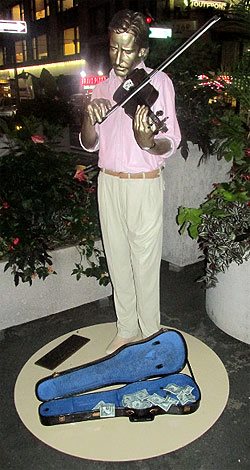
Photo by Jim Hill
… the street musician playing for tourists …

Photo by Jim Hill
Not to mention the tourists themselves.
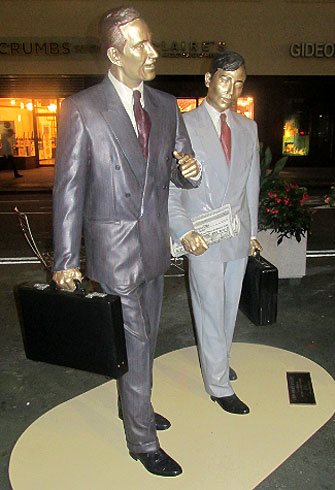
Photo by Jim Hill
But right alongside the bronze businessmen …

Photo by Jim Hill
… and the tired grandmother hauling her groceries home …

Photo by Jim Hill
… there were also statues representing people who were
from out-of-town …

Photo by Jim Hill
… or — for that matter — out-of-time.

Photo by Jim Hill
These were the Seward Johnson pieces that genuinely beguiled. Famous impressionist paintings brought to life in three dimensions.

Note the out-of-period water bottle that some tourist left
behind. Photo by Jim Hill
Some of them so lifelike that you actually had to pause for
a moment (especially as day gave way to night in the city) and say to yourself
"Is that one of the bronzes? Or just someone pretending to be one of these
bronzes?"
Mind you, for those of you who aren't big fans of the
impressionists …

Photo by Jim Hill
… there's also an array of American icons. Among them
Marilyn Monroe …
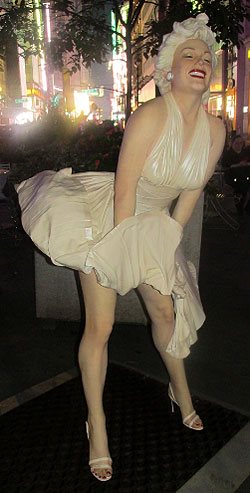
Photo by Jim Hill
… and that farmer couple from Grant Wood's "American
Gothic."

Photo by Jim Hill
But for those of you who know your NYC history, it's hard to
beat that piece which recreates Alfred Eisenstaedt's famous photograph of V-J Day in Times Square.

Photo by Jim Hill
By the way, a 25-foot-tall version of this particular Seward
Johnson piece ( which — FYI — is entitled "Embracing Peace") will actually
be placed in Times Square for a few days on or around August 14th to commemorate the 70th
anniversary of Victory Over Japan Day (V-J Day).

Photo by Jim Hill
By the way, if you'd like to check these Seward Johnson bronzes in
person (which — it should be noted — are part of the part of the Garment
District Alliance's new public art offering) — you'd best schedule a trip to
the City sometime over the next three months. For these pieces will only be on
display now through September 15th.
General
Wondering what you should “Boldly Go” see at the movies next year? The 2015 Licensing Expo offers you some clues

Greeting from the 2015 Licensing Expo, which is being held
at the Mandalay Bay
Convention Center in Las
Vegas.

Photo by Jim Hill
I have to admit that I enjoy covering the Licensing Expo.
Mostly becomes it allows bloggers & entertainment writers like myself to
get a peek over the horizon. Scope out some of the major motion pictures &
TV shows that today's vertically integrated entertainment conglomerates
(Remember when these companies used to be called movie studios?) will be
sending our way over the next two years or so.
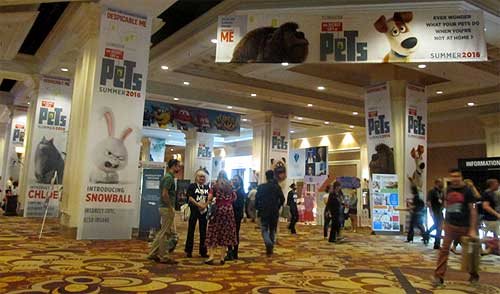
Photo by Jim Hill
Take — for example — all of "The Secret Life of
Pets" banners that greeted Expo attendees as they made their way to the
show floor today. I actually got to see some footage from this new Illumination
Entertainment production (which will hit theaters on July 8, 2016) the last time I was in Vegas. Which
was for CinemaCon back in April. And the five or so minutes of film that I viewed
suggested that "The Secret Life of Pets" will be a really funny
animated feature.

Photo by Jim Hill
Mind you, Universal Pictures wanted to make sure that Expo
attendees remembered that there was another Illumination Entertainment production
coming-to-a-theater-near-them before "The Secret Life of Pets" (And
that's "Minions," the "Despicable Me" prequel. Which
premieres at the Annecy International Animated Film Festival next week but
won't be screened stateside 'til July 10th of this year). Which is why they had
three minions who were made entirely out of LEGOS loitering out in the lobby.

Photo by Jim Hill
And Warner Bros. — because they wanted "Batman v
Superman: Dawn of Justice" to start trending on Twitter today — brought
the Batmobile to Las Vegas.
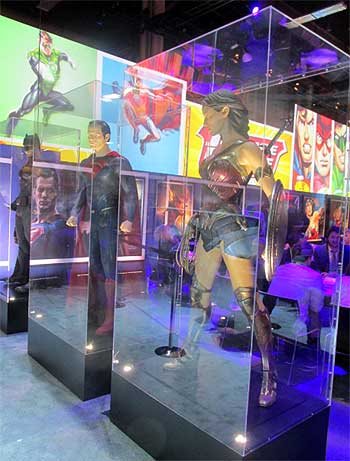
Photo by Jim Hill
Not to mention full-sized macquettes of Batman, Superman and
Wonder Woman. Just so conventioneers could then see what these DC superheroes
would actually look like in this eagerly anticipated, March 25, 2016 release.

Photo by Jim Hill
That's the thing that can sometimes be a wee bit frustrating
about the Licensing Expo. It's all about delayed gratification. You'll come
around a corner and see this 100 foot-long ad for "The Peanuts Movie"
and think "Hey, that looks great. I want to see that Blue Sky Studios production
right now." It's only then that you notice the fine print and realize that
"The Peanuts Movie" doesn't actually open in theaters 'til November
6th of this year.

Photo by Jim Hill
And fan of Blue Sky's "Ice Age" film franchise are in for an even
longer wait. Given that the latest installment in that top grossing series
doesn't arrive in theaters 'til July
15, 2016.

Photo by Jim Hill
Of course, if you're one of those people who needs immediate
gratification when it comes to your entertainment, there was stuff like that to
be found at this year's Licensing Expo. Take — for example — how the WWE
booth was actually shaped like a wrestling ring. Which — I'm guessing — meant
that if the executives of World Wrestling Entertainment, Inc. didn't like
the offer that you were making, they were then allowed to toss you out over the
top rope, Royal Rumble-style.

Photo by Jim Hill
I also have to admit that — as a longtime Star Trek fan —
it was cool to see the enormous Starship Enterprise that hung in place over the
CBS booth. Not to mention getting a glimpse of the official Star Trek 50th
Anniversary logo.
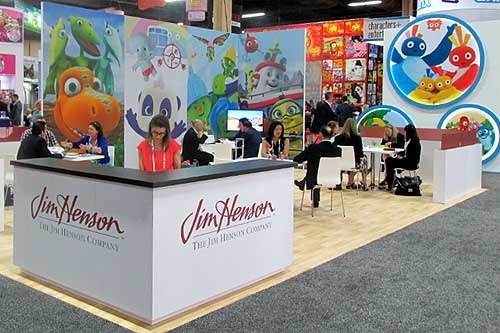
Photo by Jim Hill
I was also pleased to see lots of activity in The Jim Henson
Company booth. Which suggests that JHC has actually finally carved out a
post-Muppets identity for itself.

Photo by Jim Hill
Likewise for all of us who were getting a little concerned
about DreamWorks Animation (what with all the layoffs & write-downs &
projects that were put into turnaround or outright cancelled last year), it was
nice to see that booth bustling.

Photo by Jim Hill
Every so often, you'd come across some people who were
promoting a movie that you weren't entirely sure that you actually wanted to
see (EX: "Angry Birds," which Sony Pictures Entertainment / Columbia
Pictures will be releasing to theaters on May 20, 2016). But then you remembered that Clay Kaytis —
who's this hugely talented former Walt Disney Animation Studios animator — is
riding herd on "Angry Birds" with Fergal Reilly. And you'd think
"Well, if Clay's working on 'Angry Birds,' I'm sure this animated feature
will turn out fine."

Photo by Jim Hill
Mind you, there were reminders at this year's Licensing Expo
of great animated features that we're never going to get to see now. I still
can't believe — especially after that brilliant proof-of-concept footage
popped up online last year — that Sony execs decided not to go forward
with production of Genndy Tartakovsky's
"Popeye" movie. But that's the
cruel thing about the entertainment business, folks. It will sometime break
your heart.
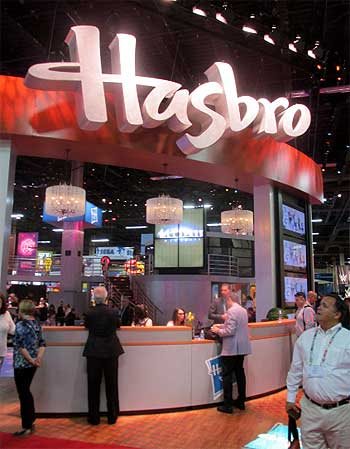
Photo by Jim Hill
And make no mistake about this. The Licensing Expo is all
about business. That point was clearly driven home at this year's show when —
as you walked through the doors of the Mandalay
Bay Convention Center
— the first thing that you saw was the Hasbros Booth. Which was this gleaming,
sleek two story-tall affair full of people who were negotiating deals &
signing contracts for all of the would-be summer blockbusters that have already
announced release dates for 2019 & beyond.

Photo by Jim Hill
"But what about The Walt Disney Company?," you
ask. "Weren't they represented on the show floor at this year's Licensing
Expo?" Not really, not. I mean, sure. There were a few companies there hyping
Disney-related products. Take — for example — the Disney Wikkeez people.
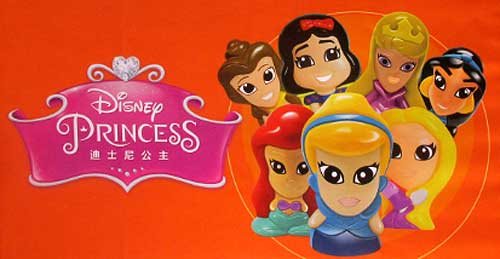
Photo by Jim Hill
I'm assuming that some Disney Consumer Products exec is
hoping that Wikkeez will eventually become the new Tsum Tsum. But to be blunt,
these little hard plastic figures don't seem to have the same huggable charm
that those stackable plush do. But I've been wrong before. So let's see what
happens with Disney Wikkeez once they start showing up on the shelves of the
Company's North American retail partners.

Photo by Jim Hill
And speaking of Disney's retail partners … They were
meeting with Mouse House executives behind closed doors one floor down from the
official show floor for this year's Licensing Expo.

Photo by Jim Hill
And the theme for this year's invitation-only Disney shindig? "Timeless
Stories" involving the Disney, Pixar, Marvel & Lucasfilm brands that
would then appeal to "tomorrow's consumer."

Photo by Jim Hill
And just to sort of hammer home the idea that Disney is no
longer the Company which cornered the market when it comes to little girls
(i.e., its Disney Princess and Disney Fairies franchises), check out this
wall-sized Star Wars-related image that DCP put up just outside of one of its
many private meeting rooms. "See?," this carefully crafted photo
screams. "It isn't just little boys who want to wield the Force. Little
girls also want to grow up and be Lords of the Sith."
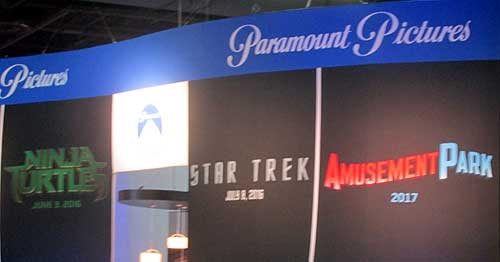
Photo by Jim Hill
One final, kind-of-ironic note: According to this banner,
Paramount Pictures will be releasing a movie called "Amusement Park"
to theaters sometime in 2017.

Photo by Jim Hill
Well, given all the "Blackfish" -related issues
that have been dogged SeaWorld Parks & Entertainment over the past two years, I'm
just hoping that they'll still be in the amusement park business come 2017.
Your thoughts?
General
It takes more than three circles to craft a Classic version of Mickey Mouse
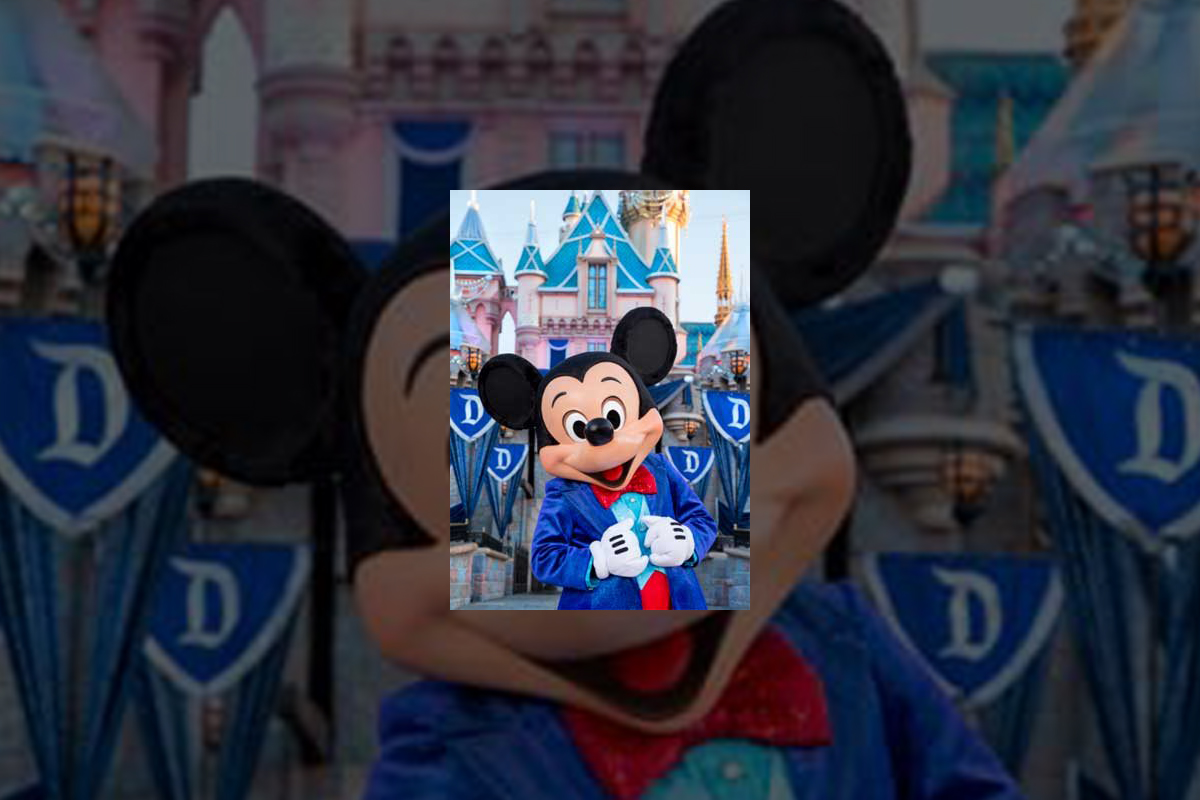
You know what Mickey Mouse looks like, right? Little guy,
big ears?
Truth be told, Disney's corporate symbol has a lot of
different looks. If Mickey's interacting with Guests at Disneyland
Park (especially this summer, when
the Happiest Place on Earth
is celebrating its 60th anniversary), he looks & dresses like this.
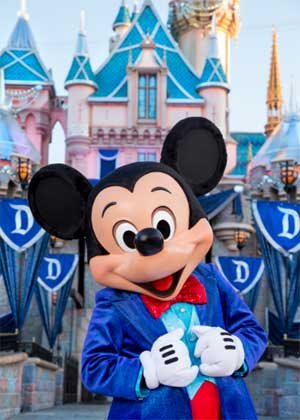
Copyright Disney Enterprises,
Inc.
All rights reserved
Or when he's appearing in one of those Emmy Award-winning shorts that Disney
Television Animation has produced (EX: "Bronco Busted," which debuts
on the Disney Channel tonight at 8 p.m. ET / PT), Mickey is drawn in a such a
way that he looks hip, cool, edgy & retro all at the same time.
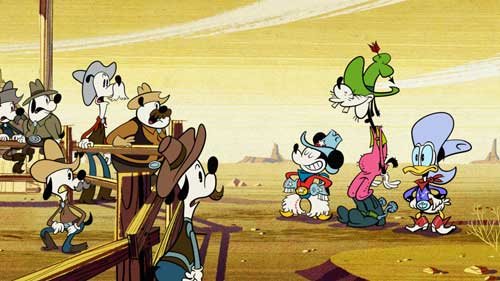
Copyright Disney Enterprises, Inc. All rights
reserved
Looking ahead to 2017 now, when Disney Junior rolls out "Mickey and the
Roadster Racers," this brand-new animated series will feature a sportier version
of Disney's corporate symbol. One that Mouse House managers hope will persuade
preschool boys to more fully embrace this now 86 year-old character.

Copyright Disney Enterprises,
Inc. All rights reserved
That's what most people don't realize about the Mouse. The
Walt Disney Company deliberately tailors Mickey's look, even his style of
movement, depending on what sort of project / production he's appearing in.
Take — for example — Disney
California Adventure
Park's "World of Color:
Celebrate!" Because Disney's main mouse would be co-hosting this new
nighttime lagoon show with ace emcee Neil Patrick Harris, Eric Goldberg really had
to step up Mickey's game. Which is why this master Disney animator created
several minutes of all-new Mouse animation which then showed that Mickey was
just as skilled a showman as Neil was.

Copyright Disney Enterprises,
Inc.
All rights reserved
Better yet, let's take a look at what the folks at Avalanche Studios just went
through as they attempted to create a Classic version of Mickey & Minnie.
One that would then allow this popular pair to become part of Disney Infinity
3.0.
"I won't lie to you. We were under a lot of pressure to
get the look of this particular version of Mickey — he's called Red Pants
Mickey around here — just right," said Jeff Bunker, the VP of Art
Development at Avalanche Studios, during a recent phone interview. "When
we brought Sorcerer Mickey into Disney Infinity 1.0 back in January of 2014,
that one was relatively easy because … Well, everyone knows what Mickey Mouse
looked like when he appeared in 'Fantasia.' "

Copyright Disney Enterprises,
Inc. All rights reserved
"But this time around, we were being asked to design
THE Mickey & Minnie," Bunker continued. "And given that these Classic
Disney characters have been around in various different forms for the better
part of the last century … Well, which look was the right look?"
Which is why Jeff and his team at Avalanche Studios began watching hours &
hours of Mickey Mouse shorts. As they tried to get a handle on which look would
work best for these characters in Disney Infinity 3.0.

Copyright Disney
Enterprises, Inc. All rights reserved
"And we went all the way back to the very start of Mickey's career. We began
with 'Steamboat Willie' and then watched all of those black & white Mickey shorts
that Walt made back in the late 1920s & early 1930s. From there, we
transitioned to his Technicolor shorts. Which is when Mickey went from being
this pie-eyed, really feisty character to more of a well-behaved leading
man," Bunker recalled. "We then finished out our Mouse marathon by
watching all of those new Mickey shorts that Paul Rudish & his team have
been creating for Disney Television Animation. Those cartoons really recapture
a lot of the spirit and wild slapstick fun that Mickey's early, black &
white shorts had."
But given that the specific assignment that Avalanche Studios had been handed
was to create the most appealing looking, likeable version of Mickey Mouse
possible … In the end, Jeff and his team wound up borrowing bits & pieces
from a lot of different versions of the world's most famous mouse. So that
Classic Mickey would then look & move in a way that best fit the sort of
gameplay which people would soon be able to experience with Disney Infinity
3.0.

Copyright Disney Enterprises,
Inc. All rights reserved
"That — in a lot of ways — was actually the toughest
part of the Classic Mickey design project. You have to remember that one of the
key creative conceits of Disney Infinity
is that all the characters which appear in this game are toys," Bunker
stated. "Okay. So they're beautifully detailed, highly stylized toy
versions of beloved Disney, Pixar, Marvel & Lucasfilm characters. But
they're still supposed to be toys. So our Classic versions of Mickey &
Minnie have the same sort of thickness & sturdiness to them that toys have.
So that they'll then be able to fit right in with all of the rest of the
characters that Avalanche Studios had previously designed for Disney Infinity."
And then there was the matter of coming up with just the
right pose for Classic Mickey & Minnie. Which — to hear Jeff tell the
story — involved input from a lot of Disney upper management.
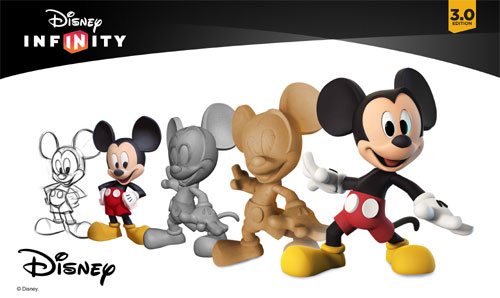
Copyright Disney Enterprises,
Inc. All rights reserved
"Everyone within the Company seemed to have an opinion
about how Mickey & Minnie should be posed. More to the point, if you Google
Mickey, you then discover that there are literally thousands of poses out there
for these two. Though — truth be told — a lot of those kind of play off the
way Mickey poses when he's being Disney's corporate symbol," Bunker said.
"But what I was most concerned about was that Mickey's pose had to work
with Minnie's pose. Because we were bringing the Classic versions of these
characters up into Disney Infinity 3.0 at the exact same time. And we wanted to
make sure — especially for those fans who like to put their Disney Infinity
figures on display — that Mickey's pose would then complement Minnie.
Which is why Jeff & the crew at Avalanche Studios
decided — when it came to Classic Mickey & Minnie's pose — that they
should go all the way back to the beginning. Which is why these two Disney icons
are sculpted in such a way that it almost seems as though you're witnessing the
very first time Mickey set eyes on Minnie.

Copyright Disney Enterprises,
Inc. All rights reserved
"And what was really great about that was — as soon as
we began showing people within the Company this pose — everyone at Disney
quickly got on board with the idea. I mean, the Classic Mickey that we sculpted
for Disney Infinity 3.0 is clearly a very playful, spunky character. But at the
same time, he's obviously got eyes for Minnie," Bunker concluded. "So
in the end, we were able to come up with Classic versions of these characters
that will work well within the creative confines of Disney Infinity 3.0 but at
the same time please those Disney fans who just collect these figures because
they like the way the Disney Infinity characters look."
So now that this particular design project is over, does
Jeff regret that Mouse House upper management was so hands-on when it came to
making sure that the Classic versions of Mickey & Minnie were specifically
tailored to fit the look & style of gameplay found in Disney Infinity 3.0?
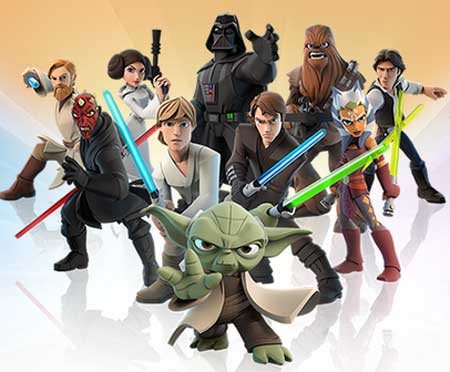
Copyright Lucasfilm / Disney
Enterprises, Inc. All rights reserved
"To be blunt, we go through this every time we add a new character to the
game. The folks at Lucasfilm were just as hands-on when we were designing the
versions of Darth Vader and Yoda that will also soon be appearing in Disney
Infinity 3.0," Bunker laughed. "So in the end, if the character's
creators AND the fans are happy, then I'm happy."
This article was originally posted on the Huffington Post's Entertainment page on Tuesday, June 9, 2015
-

 Film & Movies7 months ago
Film & Movies7 months agoBefore He Was 626: The Surprisingly Dark Origins of Disney’s Stitch
-

 History5 months ago
History5 months agoCalifornia Misadventure
-

 History10 months ago
History10 months agoThe Super Bowl & Disney: The Untold Story Behind ‘I’m Going to Disneyland!’
-

 Television & Shows11 months ago
Television & Shows11 months agoHow the Creators of South Park Tricked A-List Celebrities to Roast Universal – “Your Studio & You”
-

 Film & Movies6 months ago
Film & Movies6 months agoThe Best Disney Animation Film Never Made – “Chanticleer”
-

 Theme Parks & Themed Entertainment5 months ago
Theme Parks & Themed Entertainment5 months agoThe ExtraTERRORestrial Files
-

 History6 months ago
History6 months agoWhy Disney’s Animal Kingdom’s Beastly Kingdom Was Never Built
-

 Television & Shows8 months ago
Television & Shows8 months agoThe Untold Story of Super Soap Weekend at Disney-MGM Studios: How Daytime TV Took Over the Parks






